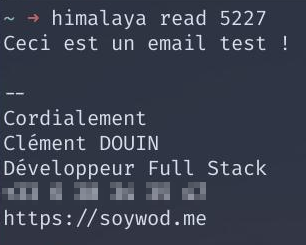| .github | ||
| .vscode | ||
| src | ||
| vim | ||
| wiki@fb38ee9b4a | ||
| .gitignore | ||
| .gitmodules | ||
| Cargo.lock | ||
| Cargo.toml | ||
| CHANGELOG.md | ||
| default.nix | ||
| flake.lock | ||
| flake.nix | ||
| install.sh | ||
| LICENSE | ||
| README.md | ||
| shell.nix | ||
📫 Himalaya 
Minimalist CLI email client, written in Rust.
The project is under active development. Do not use in production before the
v1.0.0 (see the roadmap).
Table of contents
- Motivation
- Installation
- Nix
- Configuration
- Usage
- Completions
- Interfaces
- License
- Changelog
- Sponsoring
- Credits
Motivation
Bringing emails to the terminal is a pain. The mainstream TUI, (neo)mutt, takes time to configure. The default mapping is not intuitive when coming from the Vim environment. It is even scary to use at the beginning, since you are dealing with sensitive data!
The aim of Himalaya is to extract the email logic into a simple (yet solid) CLI API that can be used either directly from the terminal or UIs. It gives users more flexibility.
Installation
curl -sSL https://raw.githubusercontent.com/soywod/himalaya/master/install.sh | sh
Read the Nix section below for a Nix-based installation method. See the wiki section for other installation methods.
Nix
Nix users might find this section relevant.
Installing using Nix
If you already have Nix installed (without Flakes), run the following command to install himalaya to your home directory:
nix-env -if https://github.com/soywod/himalaya/archive/master.tar.gz
# Or, `nix-env -if .` from within the source tree checkout
Alternatively, if you use Nix with Flakes, you can directly run himalaya without installing it anywhere:
nix run github:soywod/himalaya
# Or, `nix run` from within the source tree checkout
Development using Nix
To enter a development shell,
nix develop
From here, you have access to all the development tools (Rust compiler, cargo, rust language server, code formatter, etc.) necessary to hack on himalaya.
If you use VSCode, simply open this project folder - and accept the workspace extension recommendations.
Troubleshooting Nix
- See here if you get the
hash mismatch in fixed-output derivationerror.
Configuration
# ~/.config/himalaya/config.toml
name = "Your full name"
downloads-dir = "/abs/path/to/downloads"
signature = "Regards,"
[gmail]
default = true
email = "your.email@gmail.com"
imap-host = "imap.gmail.com"
imap-port = 993
imap-login = "your.email@gmail.com"
imap-passwd-cmd = "pass show gmail"
smtp-host = "smtp.gmail.com"
smtp-port = 487
smtp-login = "your.email@gmail.com"
smtp-passwd-cmd = "security find-internet-password -gs gmail -w"
See the wiki section for all the options.
Usage
himalaya 0.2.6
soywod <clement.douin@posteo.net>
📫 Minimalist CLI email client
USAGE:
himalaya [OPTIONS] [SUBCOMMAND]
FLAGS:
-h, --help Prints help information
-V, --version Prints version information
OPTIONS:
-a, --account <STRING> Selects a specific account
-l, --log <LEVEL> Defines the logs level [default: info] [possible values: error, warn, info, debug,
trace]
-m, --mailbox <MAILBOX> Selects a specific mailbox [default: INBOX]
-o, --output <FMT> Defines the output format [default: plain] [possible values: plain, json]
SUBCOMMANDS:
attachments Downloads all message attachments
copy Copy a message to the targetted mailbox
delete Delete a message
flags Handles flags
forward Forwards a message
help Prints this message or the help of the given subcommand(s)
idle Spawns a blocking idle daemon
list Lists all messages
mailboxes Lists all mailboxes
move Move a message to the targetted mailbox
read Reads text bodies of a message
reply Answers to a message
save Saves a raw message
search Lists messages matching the given IMAP query
send Sends a raw message
template Generates a message template
write Writes a new message
See the wiki section for more information about commands.
List mailboxes
Shows mailboxes in a basic table.
List messages
Shows messages in a basic table.
Search messages
Shows filtered messages in a basic table. The query should follow the RFC-3501.
Download attachments
Downloads all attachments from a message directly to the
downloads-dir.
Read a message
Shows the text content of a message (text/plain if exists, otherwise
text/html).
Write a new message
himalaya write
Opens your default editor (from the $EDITOR environment variable) to compose
a new message.
Reply to a message
himalaya reply --all 5123
Opens your default editor to reply to a message.
Forward a message
himalaya forward 5123
Opens your default editor to forward a message.
Copy a message
himalaya copy 5123 Sent
Copies a message to the targetted mailbox.
Move a message
himalaya move 5123 Drafts
Moves a message to the targetted mailbox.
Delete a message
himalaya delete 5123
Moves a message.
Listen to new messages
himalaya idle
Starts a session in idle mode (blocking). When a new message arrives, it runs
the command notify-cmd defined in the config
file.
Here a use case with systemd:
# ~/.config/systemd/user/himalaya.service
[Unit]
Description=Himalaya new messages notifier
[Service]
ExecStart=/usr/local/bin/himalaya idle
Restart=always
RestartSec=5
[Install]
WantedBy=multi-user.target
systemctl --user enable himalaya.service
systemctl --user start himalaya.service
Completions
Generates the completion script for the given shell
USAGE:
himalaya completion <shell>
FLAGS:
-h, --help Prints help information
-V, --version Prints version information
ARGS:
<shell> [possible values: bash, zsh, fish]
The command prints the generated script to the stdout. You will have to manually save and source them. For example:
himalaya completion bash > himalaya-completions.bash
# ~/.bashrc
source himalaya-completions.bash
Interfaces
GUI
Not yet, but feel free to contribute ;)
TUI
Sponsoring
Credits
- IMAP RFC3501
- Iris, the himalaya predecessor
- isync, an email synchronizer for offline usage
- NeoMutt, an email terminal user interface
- Alpine, an other email terminal user interface
- mutt-wizard, a tool over NeoMutt and isync
- rust-imap, a rust IMAP lib








